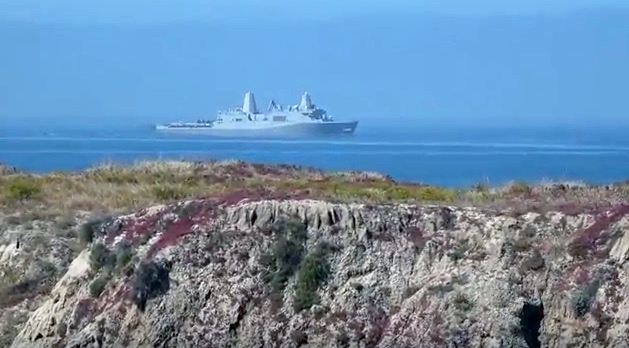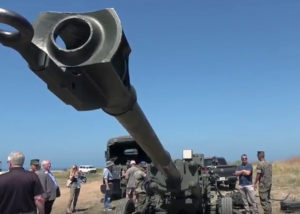
Yesterday, Flag Day, I was privileged to be among those attending a training evolution and demonstration of the Marine Air-Ground Task Force (MAGTF) concept. It took place on “the beach” at Camp Pendleton.
The event was part of Camp Pendleton’s celebration this year of its 75th anniversary and members of the community were invited to watch and learn more about the Marines and the base. I was there as a member of the local council of the Navy League, along with members of other councils.
In simple terms, MAGTF involves Navy and Marine forces — air, ground, and sea — in a coordinated amphibious operation. Navy ships bring materiel and personnel to the area, land Marines and their equipment and supplies, supported by Navy and Marine aircraft.

The event was much less whiz-bang than similar demonstrations at the annual airshow (a video of that portion of the 2014 airshow is at the end of this post), but the scale and kinds of equipment were quite different. The Camp Pendleton evolution involved Navy ships, amphibious craft, and an actual amphibious landing on an awesome stretch of sand and waves.
Here’s a video (7:00) of highlights.
The presentation also included briefings on the base itself. Camp Pendleton covers more than 125,000 acres, or just over 195 square miles. Its coastline (17.5 miles) is about the same length as New Hampshire’s. The base goes 10+ miles inland. Because of its size and location, Camp Pendleton is the only military facility in the US that allows for large-scale operations combining air, sea, and ground forces. Jet aircraft, for example, are nearly unrestricted in their operations over this area.
There are about 40,000 active duty Marines, and some Navy sailors, at Camp Pendleton on any given day. Combining family members and civilian employees, the base population on a workday is about 80,000. (Also using the base commissary, exchange, etc., are many of the approximately 80,000 retired military who live within a 50-mile radius. Including me.)
There are signs on I-5, which goes north-south up the coastline here, that say “Camp Pendleton — Preserving California’s precious resources.” That, of course, is not the purpose of Camp Pendleton, but it is the result in many cases. Without Camp Pendleton, there would be little open space between LA and San Diego. As one approaches the end of Camp Pendleton in either direction on I-5, the visual demarcation between it and San Clemente to the north or Oceanside to the south is dramatic and striking.
Just looking at the beach in the video, you can see that, with the exception of amphibious vehicles :), it’s pretty pristine. No condos lining the bluffs, etc. Camp Pendleton’s mix of beaches, bluffs, mesas, canyons, and mountains, along with the only free-flowing river in Southern California (Santa Margarita), allows one to see what this region would look like, absent several million people.

That ecosystem includes more than 1,000 species of plants, fish, and animals. Eighteen of those species are endangered and there are several that exist only on the base. The colonel who headed up the event said the road we used to walk to the observation bluff could not be improved, because it would disturb the habitat of the Pacific pocket mouse, which is endangered. Indeed, the Marines were not allowed to remove a large piece of twisted metal from the area because the mice had made it part of their habitat.
Below is the video of the MAGTF display at the 2014 airshow at Marines Corps Air Station, Miramar. (Years ago, when it was a Naval Air Station, it was the location for Top Gun, the aviation training program as well as the movie.) Action starts at the 1:09 mark.
